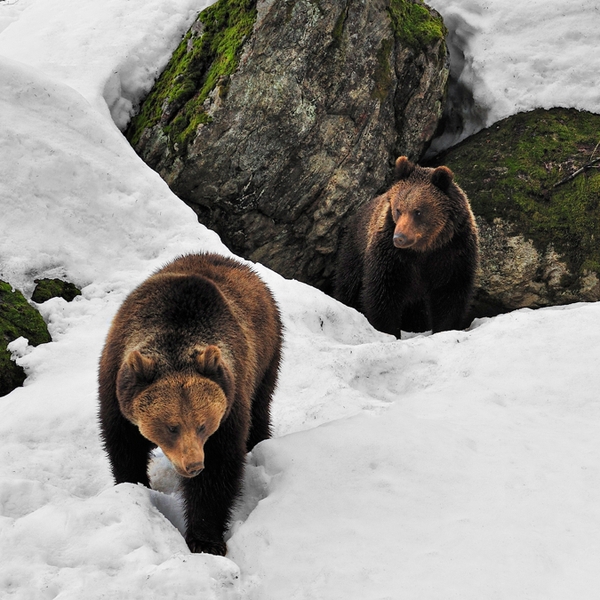It’s No Fun to Wake a Sleeping Bear
To live in the small town of Haines, Alaska, is to live with bears, with roughly one brown bear for every nine human residents. Last winter, a local snowboarder woke a hibernating brown bear in the backcountry and was severely injured, furthering tensions between food-stressed bears and anxious local residents. But in most encounters, it’s the bear that ends up dead, prompting the question of what it means to coexist.
New perk: Easily find new routes and hidden gems, upcoming running events, and more near you. Your weekly Local Running Newsletter has everything you need to lace up! .
At first glance, it appeared to be the scene of a classically gruesome bear mauling—gnashing jaws, torn flesh, crushed bones, the grim outcome of pitting fist against claw. Afterward, a man was lying in a heap on an icy slope as a streak of brown-and-silver-tinted fur tore off into the forest. Nearby, hoarfrost shimmered on hemlock branches, a bear cub peered out from a hole in the snow, and a sudden, terrifying silence echoed in the ears of the man’s ski partners.
During one of the coldest months of the year, a seasoned local snowboarder and two of his friends had gone in search of powder and instead stumbled onto a brown bear’s den. It was the most recent encounter in what had been an unprecedented year of conflicts between humans and bears in the small town of Haines, which sits on Alaska’s southeastern coastline.
The story began as it did on many bluebird winter days in February—three friends in the backcountry, doing what they loved most. Bart Pieciul, a 38-year-old Polish chef turned fisherman turned carpenter, headed into the mountains with 33-year-old Jeffrey Moskowitz, a forecaster and educator for the , and Graham Kraft, a 35-year-old ski maker and owner of , who brought along his dog, Tsirku. Nothing about their plan stood out as exceptional. They intended to access ski terrain above Chilkoot Lake, at the end of a ten-mile road that parallels the coastline north of town in an area they’d all traveled before.
Along with self-rescue equipment, the trio carried a healthy share of local mountain knowledge. Kraft is a former alpine racer who commutes by foot and ski to a treehouse he built with his wife, Moskowitz has been involved in avalanche and rescue training for more than a decade, and Pieciul is a backcountry aficionado who knows all the ski lines in Haines. They’d each spent hundreds of days in the backcountry. But they hadn’t prepared for the prospect of waking a sleeping bear.
By early afternoon, the group was skinning up a forested ridgeline, with Kraft in the lead, just out of sight of the other two men. After they’d ascended about 1,500 feet, the route became too icy for their climbing skins, so Pieciul and Moskowitz strapped their boards to their packs and transitioned to hiking, their steps punching through several inches of powder onto a hard, slippery base. Soon after, Pieciul spotted what he first thought was a “cute porcupine” 50 feet away. But the porcupine grew to an unimaginable size and transformed into a brown bear clawing its way out of the snow. Moskowitz heard Pieciul scream, “Bear, bear, bear!” When he looked back, he saw an enormous hulk of brown fur heading toward Pieciul. They’d hiked directly over the top of a bear den and now dangled in the liminal space between encounter and attack.
Behind the pulse pounding against Pieciul’s temples was the sickening realization that a sow with a cub in a den was among the worst possible scenarios for a bear encounter.
The bear’s initial motions were stiff and awkward, its head swaying slightly and its steps exaggerated as if sleepwalking. Even after shaking off its hibernation stupor and focusing its gaze on Pieciul, the animal proceeded slowly, plodding toward him on broad paws that flattened the snow and claws that clung easily to the crust layer below. Pieciul raised his arms and spoke to the bear, a practice recommended in bear safety training courses to identify oneself as human and potentially defuse a tense situation. As he backed up through the trees, Pieciul caught a brief glimpse of a second, smaller bear emerging from the den. Behind the pulse pounding against his temples was the sickening realization that a sow with a cub in a den was among the worst possible scenarios for a bear encounter.
From 30 feet away, Moskowitz watched in horror as his friend faced off with the bear. “Which way is this going to go?” he wondered. He didn’t have to wait long for an answer.
Pieciul is six feet, two inches tall and weighs 200 pounds. The bear grabbed him by his left wrist and shook him like a rag doll, hoisting him above the ground with her powerful jaws. He later described the scene to me in slow motion, recalling the nightmarish view of his own fingers flopping limply from his wrist as he was flung about.
Shortly after the initial attack, bear and man began rocketing downhill, the bear on top of Pieciul as he slid headfirst. They landed 100 feet below, where Pieciul suddenly felt “huge pressure” on his body and saw the bear’s nose and mouth as she grabbed the left side of his neck. That’s when he began to play dead. As she proceeded to bite him on the buttocks, right arm, and above his right hip, Pieciul lay quietly, making his body as still and limp as he could. He wanted the bear to know that he meant her no harm. Later, he would speak out in defense of the bear that mauled him.









